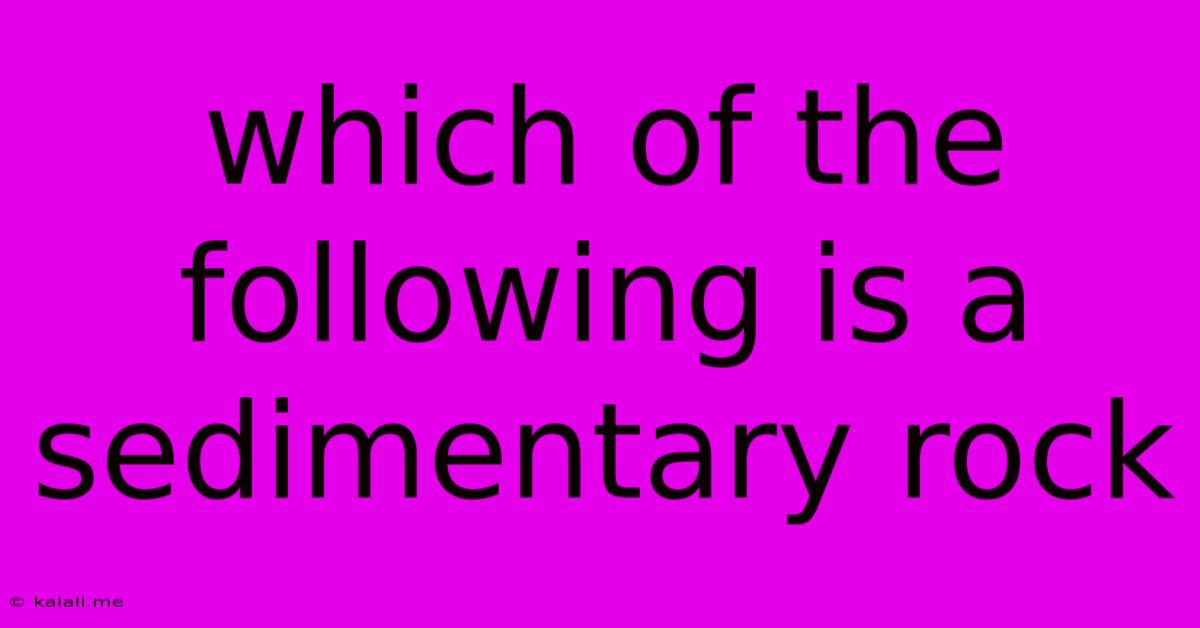Which Of The Following Is A Sedimentary Rock
Kalali
Jun 13, 2025 · 3 min read

Table of Contents
Which of the following is a sedimentary rock? Understanding Sedimentary Rock Formation
This article will explore sedimentary rocks, explaining their formation and providing examples to help you identify them. Understanding the processes involved in creating these rocks is key to answering the question: which of the following is a sedimentary rock?
Sedimentary rocks are one of the three major rock types (along with igneous and metamorphic rocks), formed from the accumulation and cementation of sediments. These sediments can be fragments of other rocks, minerals, or organic matter. The process of sedimentary rock formation is a fascinating journey, involving weathering, erosion, transportation, deposition, compaction, and cementation. Let's break this down:
The Formation of Sedimentary Rocks: A Step-by-Step Process
- Weathering: Pre-existing rocks are broken down into smaller pieces through physical (like freezing and thawing) or chemical (like acid rain) processes.
- Erosion: These weathered fragments are transported by agents like wind, water, or ice.
- Transportation: The sediments are carried to different locations, often over long distances. The size and type of sediment transported depend on the transporting agent's energy.
- Deposition: When the transporting agent loses energy (e.g., a river slowing down), the sediments settle out and accumulate in layers.
- Compaction: As more layers of sediment accumulate, the weight of the overlying layers compresses the lower layers, reducing the space between sediment particles.
- Cementation: Dissolved minerals in groundwater precipitate between the sediment particles, acting as a natural glue to bind them together, forming a solid rock.
Identifying Sedimentary Rocks: Key Characteristics
Sedimentary rocks often exhibit unique characteristics that distinguish them from other rock types. These include:
- Layering (Stratification): Sedimentary rocks are typically layered, with each layer representing a period of deposition. These layers can vary in thickness and composition.
- Fossils: The process of sedimentary rock formation often preserves the remains of ancient plants and animals, making fossils a common feature of these rocks.
- Clastic Texture: Many sedimentary rocks have a clastic texture, meaning they are made up of fragments of other rocks cemented together. The size of these fragments can vary greatly, from large boulders (conglomerates) to fine grains (sandstones and shales).
- Non-Clastic Texture: Some sedimentary rocks, like limestone, are formed from the chemical precipitation of minerals, resulting in a non-clastic texture.
Examples of Sedimentary Rocks
Several common examples of sedimentary rocks include:
- Sandstone: Formed from sand-sized grains cemented together.
- Shale: A fine-grained sedimentary rock formed from clay and silt.
- Limestone: A sedimentary rock primarily composed of calcium carbonate. Often formed from the accumulation of shells and skeletal remains.
- Conglomerate: A sedimentary rock made up of rounded pebbles and cobbles cemented together.
- Breccia: Similar to conglomerate, but with angular fragments instead of rounded ones.
Therefore, to determine which of a given list is a sedimentary rock, look for characteristics like layering, the presence of fossils, and a clastic or non-clastic texture. The examples provided above can also help you identify common sedimentary rock types. Remember to consider the formation process – the accumulation and cementation of sediments – as the defining characteristic.
Latest Posts
Latest Posts
-
Major Storage Form Of Carbohydrates In Animals
Jun 14, 2025
-
Which Cell Organelle Is The Site For Photosynthesis
Jun 14, 2025
-
All The Living Things In An Ecosystem Are Called
Jun 14, 2025
-
An Angle Whose Measure Is Exactly 90 Degrees
Jun 14, 2025
-
What Is The Mass Of 1 5 Moles Of Co2
Jun 14, 2025
Related Post
Thank you for visiting our website which covers about Which Of The Following Is A Sedimentary Rock . We hope the information provided has been useful to you. Feel free to contact us if you have any questions or need further assistance. See you next time and don't miss to bookmark.